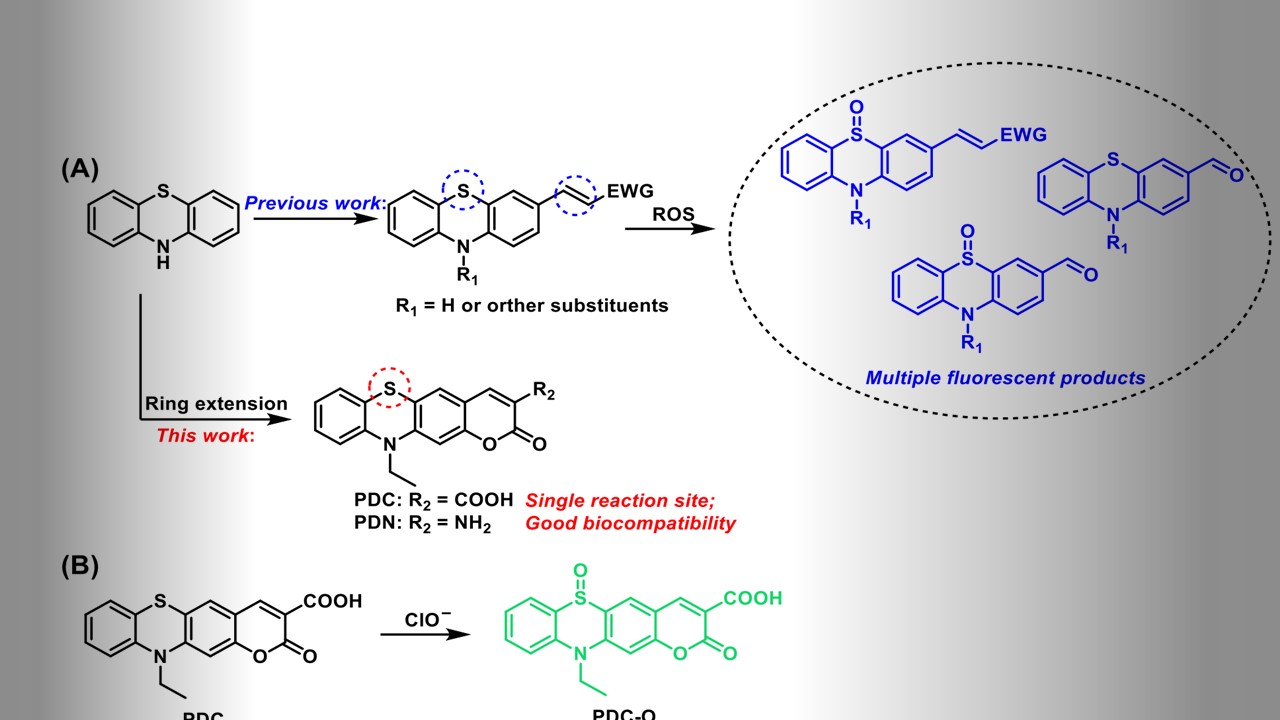Molecular Fluorescent Probe for Imaging and Evaluation of Hypochlorite Fluctuations during Diagnosis and Therapy of Osteoarthritis in Cells and in Mice Model
Ji-Ting Hou【后际挺】,a,b,† Bingya Wang,a,† Yuxia Zou【邹玉霞】,b,† Peiwen Fan,a Xueping Chang,a Xinhua Cao,a,* Shan Wang,a,* Fabiao Yu【于法标】b,*
a College of Chemistry and Chemical Engineering, Xinyang Normal University, Xinyang 464000, China.
b Key Laboratory of Emergency and Trauma, Ministry of Education, Key Laboratory of Hainan Trauma and Disaster Rescue, The First Affiliated Hospital of Hainan Medical University, Institute of Functional Materials and Molecular Imaging, Research Unit of Island Emergency Medicine, Chinese Academy of Medical Sciences (No. 2019RU013), College of Emergency and Trauma, Hainan Medical University, Haikou 571199, China
Abstract
 The early diagnosis of osteoarthritis (OA) can halt or delay the progression of the disease, and it is essentially beneficial to its treatment. However, biomarkers with sufficient sensitivity for dynamically identifying early OA are still yet to be determined. The overproduced hypochlorous acid (HOCl) has been proposed as an obvious symptom in early OA. Herein, based on the oxidation reaction of the sulfur atom in phenothiazine into sulfoxide, we design and synthesize a phenothiazine-derived coumarin fluorescent probe PDC for the detection of ClO– in cells and in an OA mouse model. The probe PDC exhibits excellent selectivity and sensitivity for ClO– detection with a limit of detection as low as 16.1 nM. Taking advantage of the probe PDC, we visualize and evaluate the level changes of ClO– in macrophage cells, which is stimulated by various inflammatory factors. The anti-inflammatory and therapeutic effects of selenocysteine and methotrexate in inflamed cells are also confirmed. Finally, with in vivo imaging of ClO– concentration changes in OA BALB/c mouse models, we successfully inspected the relationship between OA phenotypes and the burst of ClO–. We suggest that abnormal changes in HOCl concentration may be considered as a new biomarker for the early OA diagnosis.
The early diagnosis of osteoarthritis (OA) can halt or delay the progression of the disease, and it is essentially beneficial to its treatment. However, biomarkers with sufficient sensitivity for dynamically identifying early OA are still yet to be determined. The overproduced hypochlorous acid (HOCl) has been proposed as an obvious symptom in early OA. Herein, based on the oxidation reaction of the sulfur atom in phenothiazine into sulfoxide, we design and synthesize a phenothiazine-derived coumarin fluorescent probe PDC for the detection of ClO– in cells and in an OA mouse model. The probe PDC exhibits excellent selectivity and sensitivity for ClO– detection with a limit of detection as low as 16.1 nM. Taking advantage of the probe PDC, we visualize and evaluate the level changes of ClO– in macrophage cells, which is stimulated by various inflammatory factors. The anti-inflammatory and therapeutic effects of selenocysteine and methotrexate in inflamed cells are also confirmed. Finally, with in vivo imaging of ClO– concentration changes in OA BALB/c mouse models, we successfully inspected the relationship between OA phenotypes and the burst of ClO–. We suggest that abnormal changes in HOCl concentration may be considered as a new biomarker for the early OA diagnosis.
KEYWORDS:
fluorescent probe hypochlorite osteoarthritis inflammation mouse model
Scheme 1. (A) Design Strategy of Phenothiazine-Derived Fluorescent Probes; (B) Proposed Reaction Mechanism between Probe PDC and ClO
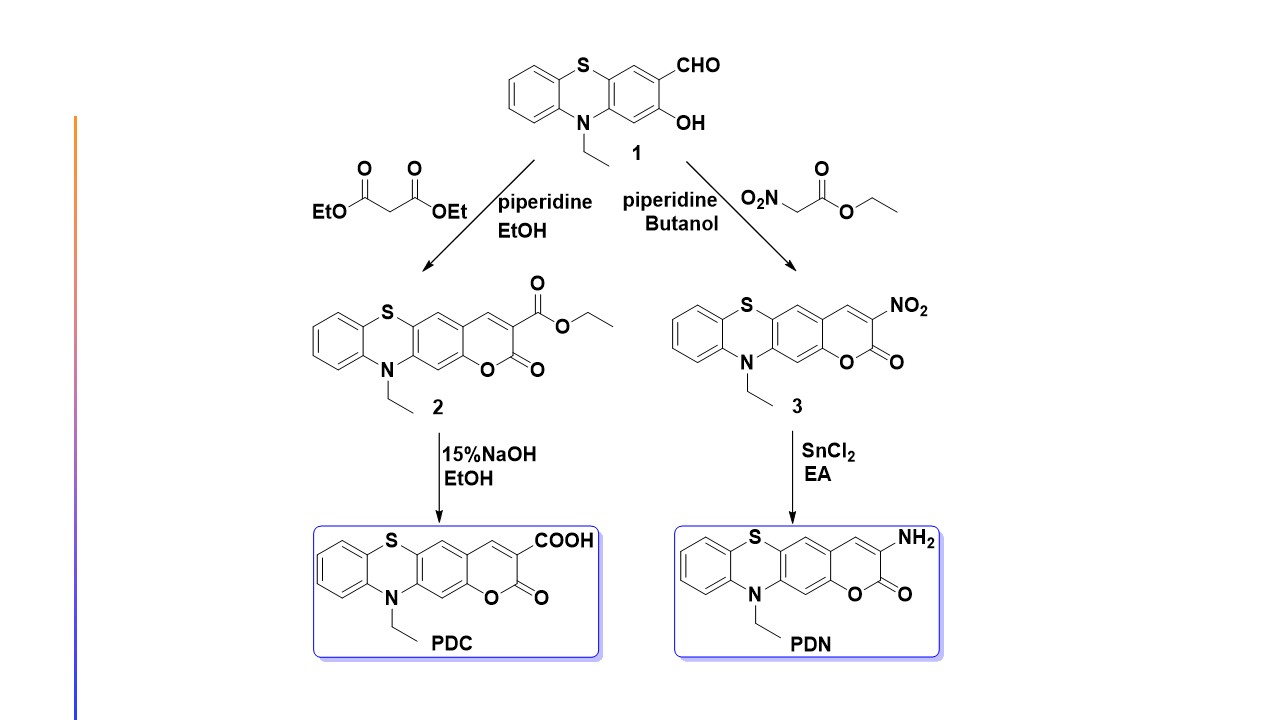
Scheme 2. Synthesis of Probes
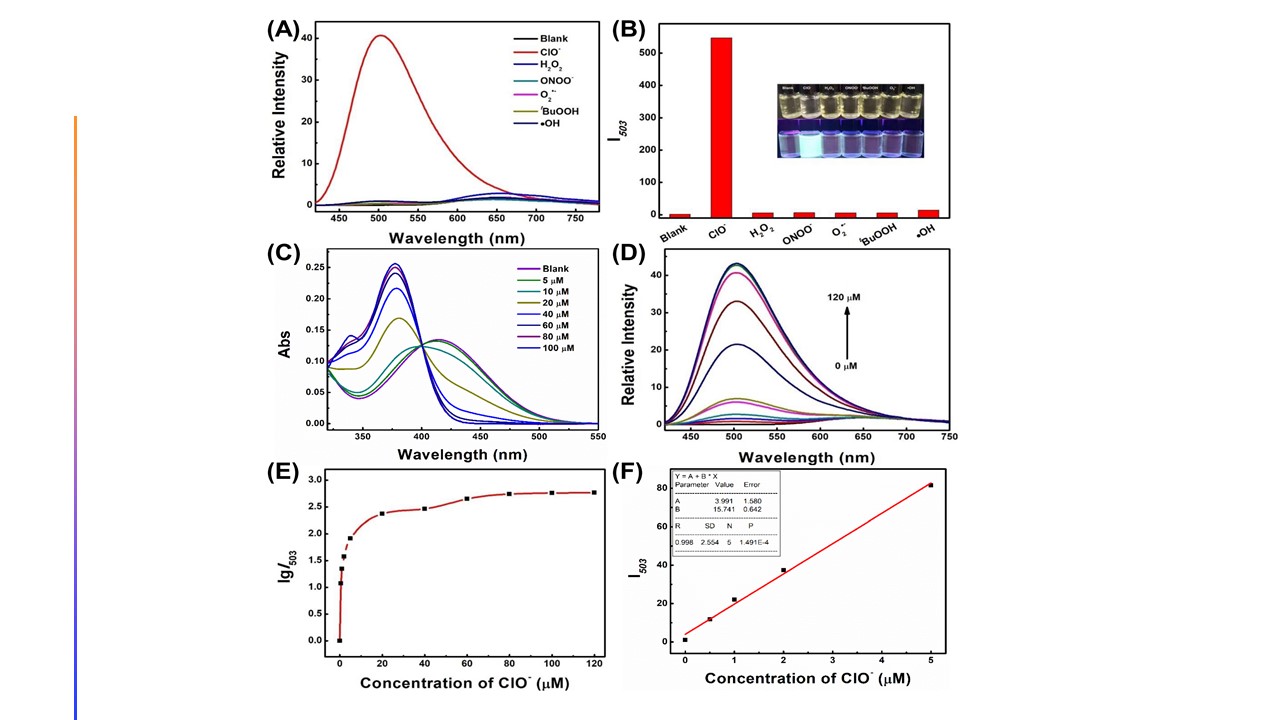
Figure 1. (A) Emission spectra of the probe PDC (10 μM) before and after addition of various reactive species (100 μM) in PBS solution (pH 7.2–7.4, 10 mM); (B) intensity changes of PDC before and after addition of various reactive species. Inset: photography of probe PDC with or without ROS under daylight (top) and a 365 nm UV lamp (bottom), respectively; (C) UV–vis titration of PDC toward various concentrations of ClO– in PBS solution.; (D) fluorescence titration of PDC (10 μM) toward various concentrations of ClO– in PBS solution; (E) relationship between lgI503 and ClO–; (F) linear relationship between fluorescence intensity (I503) of PDC (10 μM) and various concentrations of ClO–. λex = 400 nm; slit widths: 5 nm/5 nm.
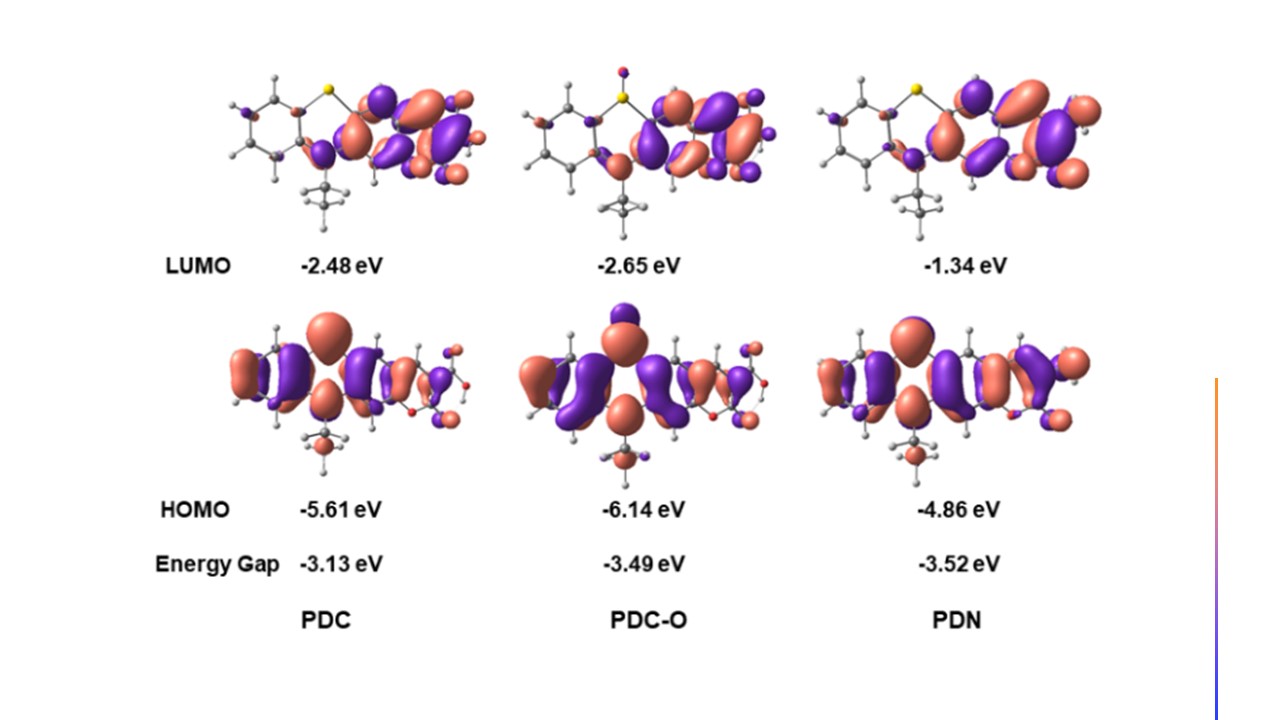
Figure 2. Molecular orbital plots for the lowest unoccupied molecular orbital (LUMO) and the highest occupied molecular orbital (HOMO) and the HOMO/LUMO energy gap of molecules PDC, PDC-O, and PDN.

Figure 3. Evaluation of the generation of ClO– in RAW 264.7 cells treated with different stimuli using probe PDC. (A) Cells were treated with probe PDC for 10 min and then incubated with stimuli for 0, 30, 60, and 90 min before confocal imaging. (a) Control; (b) IL-1 (1.0 pg/mL); (c) TNF-α (1.0 pg./mL); (d) LPS (1.0 μg/mL); (e) IL-1&TNF-α&LPS (1.0 pg/mL, 1.0 pg/mL, and 1.0 μg/mL). (B) Fluorescence intensity collected from images a1–a4. (C) Fluorescence intensity collected from images b1–b4. (D) Fluorescence intensity collected from images c1–c4. (E) Fluorescence intensity collected from images d1–d4. (F) Fluorescence intensity collected from images e1–e4. Statistical analysis was performed using Student’s t test (n = 3). *P < 0.05, error bars are mean ± SD, n = 3.
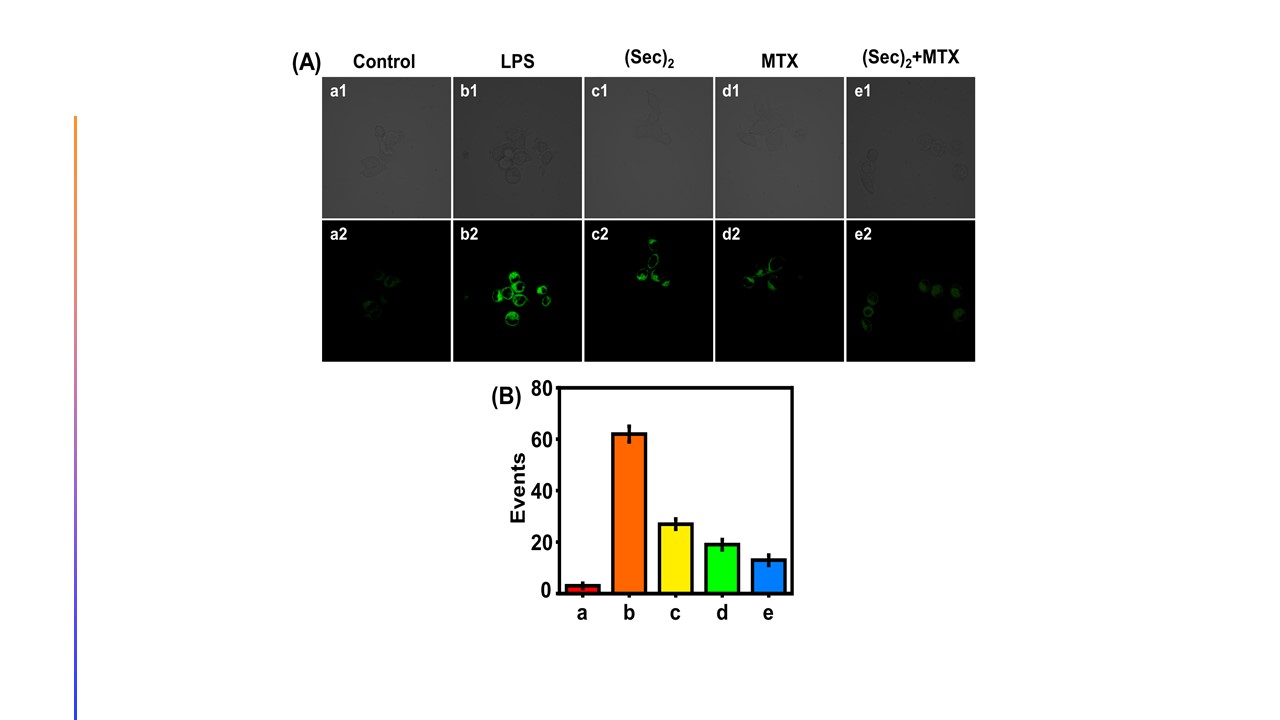
Figure 4. Protective effects of different agents in inflamed RAW 264.7 cells using probe PDC. (A) (a) Cells were treated with probe PDC for 10 min; (b) cells were incubated with LPS (1.0 μg/mL) for 36 h and then treated with probe PDC for 10 min; (c) cells were treated with LPS for 1 h and then co-cultured with (Sec)2 (1.0 μg/mL) and LPS for another 35 h. Probe PDC was incubated for 10 min before imaging. (d) Cells were treated with LPS for 1 h and then cultured with MTX (1.0 μg/mL) for 35 h. Probe PDC was incubated for 10 min before imaging. (e) Cells were treated with LPS for 1 h and then cultured with (Sec)2 (1.0 μg/mL) and MTX (1.0 μg/mL) for 35 h. Probe PDC was incubated for 10 min before imaging. (B) Fluorescence intensity collected from images a–e. Error bars are mean ± SD, n = 3.

Figure 5. Protective effects of different agents in BALB/c mice with the OA model using probe PDC: (a) control. (b) right knees of six to eight week-old BALB/c mice injected with LPS (5 mg/mL, PBS) every day and then administered with probe PDC (0.1 mL, 10 μM, DMSO/PBS = 1:1, V:V) before in vivo imaging after a few weeks. (c) (Sec)2 (500 μg/kg) i.p. injected every day before LPS administration; (d) MTX (100 μg/kg) i.p. injected every day before LPS administration; (e) (Sec)2 (500 μg/kg) and MTX (100 μg/kg) i.p. injected every day before LPS administration. (B) Fluorescence intensity collected from (a); (C) fluorescence intensity collected from (b); (D) fluorescence intensity collected from image (c); (E) fluorescence intensity collected from image (d); (F) fluorescence intensity collected from image (e). Statistical analysis was performed using Student’s t test (n = 3). *P < 0.05, error bars are ±SD. (G) Representative H&E staining of the knee slices from the mice treated under various conditions.
Conclusions
In summary, we have developed two phenothiazine-derived coumarin probes PDC and PDN for the detection of ClO– in cells and in OA mouse models. Carboxyl-substituted probe PDC provides a higher sensitivity and selectivity toward ClO– in PBS compared with amino-substituted probe PDN. Probe PDC is also verified to be highly biocompatible and cell membrane-permeable. In RAW 264.7 cells stimulated by various inflammatory factors, the overgeneration of ClO– was further visualized using probe PDC, as well as the anti-inflammatory effects of Sec and MTX. Finally, in vivo imaging of ClO– in OA BALB/c mouse models was successfully performed for the first time. Based on the facts that low-grade inflammation is observed in OA and MPO is overexpressed in early OA, we speculated that HOCl was overproduced in early OA. Since our probe can sensitively detect HOCl upregulation in OA mice stimulated by LPS, it is a potential chemical tool for the diagnosis of early OA by using ClO– as a new potential biomarker.
转载本文请联系原作者获取授权,同时请注明本文来自于法标科学网博客。
链接地址:https://wap.sciencenet.cn/blog-2438823-1241514.html?mobile=1
收藏


